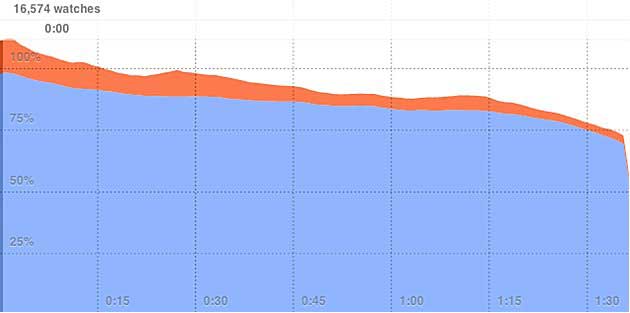Let's face it, video is hot—and everyone knows it. Video gets people more excited and engaged with the message we marketers are trying to convey than do paragraphs of text. But one major problem most of marketers have with video is this: How the heck do you measure the success of a video?
Most of us look at the play count to measure the success of our work. But is that really the best way?
Let's say a million people watched a video, but on average they watched the first 10 seconds of it before leaving the site it's on. Is that really a successful video? What if a million people came to the page where you hosted the video but only 10,000 actually clicked to watch it, are you doing a good job? The answer isn't clear: You got a lot of people to watch it, but they were not very engaged.
We've been attacking this very pain point of video success measurement ever since we started our company, Wistia, which aims to help small businesses figure out whether their videos are successful. Recently we analyzed millions of videos we host, and we found three main metrics that marketers should use to measure the success of their videos.
1. The 'Engagement' Metric
Engagement is the metric we salivate over every day at Wistia: How long are viewers spending on watching your video. Are they watching the entire video? When do they drop off?
On our blog we publish a lot of how-to tutorials on how to film, edit, and market video content, and we judge the success of our videos first and foremost by the engagement metric. For example we created the following video and published it on our blog:
Starting from our first blog reader who saw this blog post and clicked play on the video, we watched the engagement (i.e., how long each user watched the video) on a single-user basis:

It's also interesting to look at engagement in aggregate, without folks who repeatedly watched the video, to see on average how long people stick with watching the video:

The engagement metric gives us an idea of how sticky the video is and how engaging the content really is: Did we do a good job at creating the content for this video? Is the content valuable to the viewers? Knowing that helps us measure the success of the video. If most viewers are watching most of the video, we know we're doing well.
2. The 'Play Rate' Metrics
The play rate metric is absolutely crucial to use in measuring the success of your video. When visitors see your video embedded in a blog post, how many of them actually click the play button? That largely depends on the thumbnail image you have showing on your video.
To determine which image is the most appealing, test different thumbnails and then simply analyze the data behind how many people actually click play on the videos displaying different thumbnails.


Let's take a look at the data for the first image:

As you can see 91% of the people who visited the blog post with the first video embedded in it actually clicked play.
This metric is crucial in helping measure how successful a thumbnail was at encouraging people into clicking play.
3. The 'Number of Plays Over Time' Metric
The third metric is the number of plays over time. Instead of looking at the aggregate number of plays on the video as a success metric, we look at a more meaningful metric: the number of plays that the video keeps getting for each day after it's launched.
If your video keeps getting shared and watched over and over again, you'll see the number of views either increase or stay relatively the same, day to day, week to week, and month to month. Of course if the video content is not very sticky, you'll see the number of plays diminish day to day. Here is an example:

* * *
If you're going to remember anything from this article, I'd love for it to be this: Looking at the total number of plays of your video is a poor way to measure success of a video.
Much better ways to figure out whether your video is really successful are (1) how many people click play on the video when they see it embedded in a blog post (for example); (2) how long people spend watching your video; and (3) what is the number of plays over time (each day, each week, each month).



